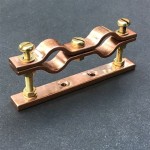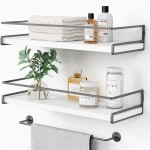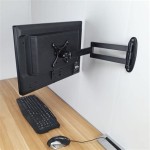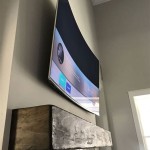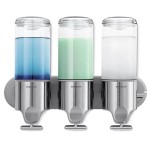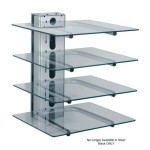Wall Mount Sink Support Legs: Ensuring Stability and Style
Wall-mounted sinks offer a sleek and modern aesthetic to bathrooms, kitchens, and even utility spaces. This design choice maximizes floor space, making cleaning easier and creating a visually open environment. However, unlike traditional pedestal sinks that have their own support structure, wall-mounted sinks rely on the wall for stability. While the mounting hardware and wall construction contribute significantly to the sink's secure installation, the addition of wall mount sink support legs can offer an extra layer of insurance and enhance the overall design.
This article delves into the world of wall mount sink support legs, exploring their purpose, types, materials, installation considerations, and aesthetic impact. It aims to provide comprehensive information for homeowners, contractors, and designers seeking to understand the benefits and nuances of incorporating these supports into their projects. Understanding the different factors involved in selecting and installing these supports will help ensure that the sink is not only visually appealing but also structurally sound and capable of withstanding daily use.
The Purpose and Benefits of Support Legs
The primary function of wall mount sink support legs is to provide additional support to the sink basin, mitigating the stress placed solely on the wall and mounting hardware. This is especially critical for heavier sinks, such as those made of stone, concrete, or cast iron, or in situations where the wall's structural integrity is questionable. Support legs help distribute the weight, preventing potential sagging, cracking, or even detachment from the wall over time. This is particularly important in older homes or those where the wall structure may not be perfectly square or reinforced.
Beyond just providing structural support, wall mount sink support legs can also enhance the longevity of the sink and its installation. By reducing the strain on the mounting hardware, they minimize the risk of loosening or failure, which can lead to costly repairs. This is particularly important for sinks that are frequently used or subjected to heavy loads. The added stability also contributes to a quieter operation, reducing vibrations and movement, which can be especially noticeable with heavier sinks.
Another significant benefit is the added safety they offer, especially in households with children or elderly individuals. The robust support provided by the legs helps prevent accidental dislodging of the sink, reducing the risk of injury. This is particularly important in bathrooms where the sink might be used as a point of support. Furthermore, the support legs can also act as a visual reinforcement, providing a sense of security and stability to users.
Moreover, wall mount sink support legs also offer an opportunity to enhance the overall aesthetic of the bathroom or kitchen. With a wide variety of styles, finishes, and materials available, they can be chosen to complement the sink design, the faucet fixtures, and the overall decor of the space. They can serve not only as functional supports but also as decorative elements that contribute to the visual appeal of the room.
Types of Wall Mount Sink Support Legs
Wall mount sink support legs come in various designs, each offering different levels of support and aesthetic appeal. Understanding these different types is crucial for selecting the right supports for a specific project.
Standard Support Legs: These are perhaps the most common type, typically constructed from metal and featuring a simple, straight or slightly curved design. They are designed to provide direct vertical support from the floor to the underside of the sink. They are usually adjustable in height to accommodate variations in floor and sink height. Finishes range from chrome to brushed nickel to painted options, allowing for seamless integration with the existing fixtures.
Decorative Support Legs: These types prioritize aesthetics, often featuring ornate designs, intricate carvings, or unique shapes. They are available in a wide range of materials, including brass, wrought iron, and even wood. Decorative support legs can elevate the overall look of the bathroom, adding a touch of elegance or personality. However, it is important to ensure that their decorative elements do not compromise their structural integrity and ability to provide adequate support.
Adjustable Height Support Legs: These are particularly useful when dealing with uneven floors or sinks that require precise height adjustments. They typically feature a threaded rod that allows for fine-tuning of the height, ensuring a level and stable installation. This is especially important in older homes where floors may have settled over time. These are often preferred in commercial settings or areas where accessibility standards need to be met.
Concealed Support Legs: These are designed to be hidden from view, providing support without detracting from the minimalist aesthetic of a wall-mounted sink. They are often embedded within the wall or cleverly disguised to blend seamlessly with the surrounding surfaces. This is a popular choice for modern bathrooms where a clean and uncluttered look is desired.
Floating Shelf Support Legs: This type combines the function of support with an integrated shelf, providing extra storage space beneath the sink. The shelf can be used to store towels, toiletries, or other bathroom essentials, maximizing functionality in a small space. The support legs for this design are generally more robust to support the weight of the shelf and its contents.
Materials and Finishes
The material and finish of wall mount sink support legs play a significant role in their durability, aesthetic appeal, and overall cost. Selecting the appropriate materials is crucial for ensuring that the supports will withstand the demands of daily use and maintain their appearance over time.
Stainless Steel: This is a popular choice due to its durability, corrosion resistance, and modern aesthetic. Stainless steel support legs are easy to clean and maintain, making them ideal for bathrooms and kitchens. They are available in various finishes, including polished, brushed, and matte.
Brass: Brass offers a classic and elegant look, adding a touch of sophistication to any bathroom. It is naturally resistant to corrosion and can be polished to a high shine or left unlacquered to develop a patina over time. Brass support legs are often used in traditional or vintage-inspired bathrooms.
Wrought Iron: Wrought iron provides a rustic and sturdy appearance, making it suitable for farmhouse or industrial-style bathrooms. It is typically coated with a protective finish to prevent rust and corrosion. Wrought iron support legs can be customized with various designs and finishes.
Wood: While less common than metal options, wood support legs can add warmth and character to a bathroom. They are typically made from durable hardwoods like oak or maple and sealed with a water-resistant finish to protect them from moisture. Wood support legs require regular maintenance to prevent water damage.
Chrome: This finish offers a bright and reflective surface that is easy to clean and maintain. Chrome support legs are a popular choice for modern bathrooms and kitchens due to their sleek and contemporary look.
Brushed Nickel: Brushed nickel provides a softer and more muted appearance compared to chrome. It is less prone to fingerprints and water spots, making it a practical choice for high-traffic areas. Brushed nickel support legs are versatile and can complement a wide range of design styles.
Powder-Coated: This finish offers a durable and scratch-resistant surface that is available in a wide range of colors. Powder-coated support legs are a good option for those who want to match the supports to their specific color scheme.
The selection of material and finish must consider the sink's material and the overall style of the room to maintain a cohesive and harmonious design. It is also important to consider the environment in which the sink is located, selecting materials that will withstand the humidity and moisture levels in the space.
Installation Considerations
Proper installation of wall mount sink support legs is crucial for ensuring their effectiveness and longevity. Incorrect installation can compromise the stability of the sink and potentially lead to damage or injury. It is generally recommended to consult with a qualified plumber or contractor to ensure that the supports are installed correctly. However, understanding the basic steps involved can empower homeowners to make informed decisions and oversee the installation process effectively.
Wall Structure: The first step is to assess the wall structure to ensure that it is strong enough to support the sink and the support legs. Ideally, the wall should be constructed of solid wood framing or reinforced concrete. Avoid installing wall mount sinks on flimsy drywall without adequate backing. If the wall is not strong enough, it may be necessary to add additional framing or reinforcement.
Accurate Measurements: Precise measurements are essential for ensuring that the support legs are properly aligned and positioned. Use a level to ensure that the legs are perfectly vertical and that the sink is level. Double-check all measurements before drilling any holes.
Secure Fastening: Use appropriate anchors and fasteners to securely attach the support legs to the wall and the floor. The type of fastener will depend on the wall material and the weight of the sink. Consult with a hardware specialist to determine the best fasteners for your specific application.
Height Adjustment: If using adjustable height support legs, fine-tune the height to ensure that the sink is level and stable. Adjust the legs until the sink sits evenly on the supports and there is no wobble or movement. Tighten the locking mechanisms to secure the adjustment.
Sealing: Apply sealant around the base of the support legs where they meet the floor to prevent water from seeping underneath. This will help protect the floor from water damage and prevent mold growth.
Load Testing: After installation, test the sink by applying weight to it and checking for any signs of instability. If the sink feels wobbly or insecure, re-evaluate the installation and make any necessary adjustments. It is also important to periodically inspect the support legs for any signs of damage or corrosion and address any issues promptly.
Proper planning, careful execution, and the use of quality materials are essential for a successful installation. While the installation process might seem straightforward, it is important to prioritize safety and structural integrity to ensure that the wall-mounted sink remains stable and secure for years to come.
Aesthetic Considerations and Design Integration
While functionality is paramount, the aesthetic impact of wall mount sink support legs should not be overlooked. The supports can be an integral part of the overall design, contributing to the style and atmosphere of the bathroom or kitchen. Choosing the right support legs can elevate the look of the space, creating a cohesive and visually appealing environment.
Matching Fixtures: Select support legs that complement the existing fixtures in the bathroom, such as the faucet, towel bars, and showerhead. Matching the finishes and styles can create a unified and harmonious look. For example, chrome support legs would pair well with chrome faucets, while brushed nickel supports would complement brushed nickel fixtures.
Complementing the Sink: Consider the style and material of the sink when choosing support legs. For a modern ceramic sink, sleek stainless steel or chrome supports might be a good choice. For a rustic stone sink, wrought iron or wooden supports could be more appropriate.
Considering the Overall Style: The support legs should fit seamlessly into the overall design style of the bathroom. In a minimalist bathroom, concealed supports or simple, understated legs might be preferred. In a more decorative bathroom, ornate or intricately designed supports can add a touch of elegance.
Color Coordination: Choose support legs that coordinate with the color scheme of the bathroom. If the bathroom has a neutral color palette, you can opt for support legs in a contrasting color to add a pop of visual interest. Alternatively, you can choose support legs in a similar color to create a more subtle and cohesive look.
Creating a Focal Point: Decorative support legs can be used to create a focal point in the bathroom. Choose a unique and eye-catching design that draws attention to the sink area. This can be a particularly effective way to add personality to a small bathroom.
By carefully considering the aesthetic aspects of wall mount sink support legs, homeowners and designers can create bathrooms and kitchens that are not only functional but also visually stunning. The supports can be more than just functional elements; they can be an integral part of the overall design, contributing to the style and atmosphere of the space.

Jones Stephens 31 3 4 In Adjustable Round Contemporary Lavatory Legs For Wall Mounted Sinks Chrome 2 Pack L65010

Jones Stephens 31 3 4 In Adjustable Round Contemporary Lavatory Legs For Wall Mounted Sinks Chrome 2 Pack L65010

Ez Flo 28 In Metal Bathroom Sink Legs 34031 At Com

How To Build Support Legs For Your Wall Mounted Sink Doityourself Com

How To Remove And Install A Wall Mounted Sink In 2 Steps 1 Tom Plumber

31 1 2 In Adjustable Hexagonal Traditional Lavatory Legs For Wall Mounted Sinks

How To Build Support Legs For Your Wall Mounted Sink Doityourself Com

Sink Frame Support Pipe Legs Base Black Stand Metal Table Mainstay Prop Iron Etsy

Kingston Brass Hartford Vpb39171 Stainless Steel Console Sink Legs Polished Chrome

Sink Base Frame Support Pipe Legs Black Stand Metal Table Mainstay Prop Etsy


